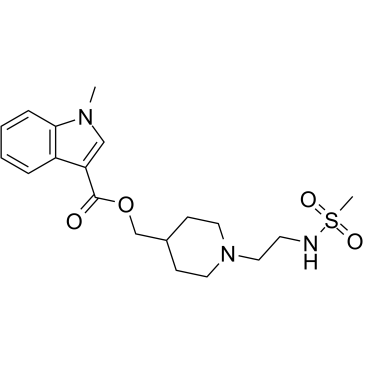Modulation of hippocampal excitability by 5-HT4 receptor agonists persists in a transgenic model of Alzheimer's disease.
J P Spencer, J T Brown, J C Richardson, A D Medhurst, S S Sehmi, A R Calver, A D Randall
文献索引:Neuroscience 129(1) , 49-54, (2004)
全文:HTML全文
摘要
5-HT(4) receptors are widely distributed in both peripheral and central nervous systems where they couple, via a G-protein, to the activation of adenylate cyclase. In the brain, the highest 5-HT(4) receptor densities are found in the limbic system, including the hippocampus and frontal cortex. It has been suggested that activation of these receptors may be of therapeutic benefit in diseases that produce cognitive deficits such as Alzheimer's disease (AD). Previous electrophysiological studies have shown that the 5-HT(4) agonist, Zacopride, can increase population spike amplitude recorded in region CA1 of rat hippocampal slices in a cyclic AMP (cAMP)/cAMP-dependent protein kinase A-dependent manner. We report here that the 5-HT(4) agonist, Prucalopride, and the 5-HT(4) partial agonist, SL65.0155, produce a similar effect in rat hippocampal slices and that the specific 5-HT(4) antagonist, GR113808, blocks these effects. To investigate the potential use of 5-HT(4) agonists in the treatment of AD, Prucalopride was applied to hippocampal slices from a transgenic mouse line that overexpresses the Abeta peptide. Despite the deficit in synaptic transmission present in these mice, the percentage increase of the CA1 population spike induced by Prucalopride was the same as that observed in wild-type mice. These data support 5-HT(4) receptors as a target for cognitive enhancement and suggest that a partial agonist would be sufficient to produce benefits, while reducing potential peripheral side effects. In addition, we show that 5-HT(4) receptors remain functional in the presence of excess Abeta peptide and may therefore be a useful target in AD.
相关化合物
| 结构式 | 名称/CAS号 | 分子式 | 全部文献 |
|---|---|---|---|
 |
反式-6-氰基-3,4-二氢-2,2-二甲基-4-(2-氧吡咯啉-1-基)-2H-1-苯丙吡喃-3-醇
CAS:144625-51-4 |
C19H27N3O4S |
|
Novel antagonists of serotonin-4 receptors: synthesis and bi...
2009-03-15 [Bioorg. Med. Chem. 17 , 2607-2622, (2009)] |
|
Dual role of serotonin in the pathogenesis of indomethacin-i...
2012-09-01 [Pharmacol. Res. 66(3) , 226-34, (2012)] |
|
Molecular characterization of a purified 5-HT4 receptor: a s...
2005-05-27 [J. Biol. Chem. 280(21) , 20253-60, (2005)] |
|
A 5-HT4 agonist, mosapride, enhances intrinsic rectorectal a...
2005-08-01 [Am. J. Physiol. Gastrointest. Liver Physiol. 289(2) , G351-60, (2005)] |
|
5-HT4 and 5-HT2 receptors antagonistically influence gap jun...
2010-01-01 [J. Mol. Cell. Cardiol. 48(1) , 220-9, (2010)] |